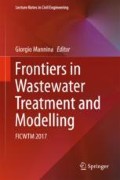Abstract
In this study, a Sharon-Anammox system was started up and fed with an ammonium-rich (1,500 mgNH4-N L−1) synthetic medium simulating the effluent produced by double-stage anaerobic digestion of food waste (AD-FW). The effects of different process parameters (e.g., hydraulic retention time, nitrogen loading rate, etc.) and influent characteristics (e.g., influent alkalinity) on reactors performance were thoroughly evaluated. As to the Sharon reactor, reducing the hydraulic retention time did not cause any detrimental effect on overall process performance (the observed NH4-N removal efficiency and effluent NO2-N/NH4-N molar ratio were 60.8 ± 4.5% and 1.58 ± 0.27, respectively), although a slightly longer time was required to achieve process stability. The Anammox reactor was able to withstand the same nitrogen loading rates applied to the Sharon unit, and the observed nitrogen removal rate was high (89.9 ± 0.5%), indicating good process performance. The information gathered in this preliminary study will be useful for the treatment of real AD-FW wastewater.
References
Amann R, Krumholz L, Stahl DA (1990) Fluorescent-oligonucleotide probing of whole cells for determinative, phylogenetic, and environmental studies in microbiology. J Bacteriol 172(2):762–770
Daims H, Lücker S, Wagner M (2006) Daime, a novel image analysis program for microbial ecology and biofilm research. Environ Microbiol 8:200–213
Ficara E, Rozzi A (2001) pH-stat titration to assess nitrification inhibition. J Environ Eng 127:698–704
Loy A, Maixner F, Wagner M, Horn M (2007) ProbeBase - an online resource for rRNA-targeted Oligonucleotide probes: new features. Nucleic Acids Res 35:800–804
Lotti T, Kleerebezem R, Lubello C, Van Loosdrecht MCM (2014) Physiological and kinetic characterization of a suspended cell anammox culture. Water Res 60:1–14
Milia S, Perra M, Cappai G, Carucci A (2015) SHARON process as preliminary treatment of refinery wastewater with high organic carbon-to nitrogen ratio. Desalin Water Treat 57:17935–17943
Roy S, Das D (2016) Biohythane production from organic wastes: present state of art. Environ Sci Pollut Res 23:9391–9410
Van de Graaf AA, De Bruijn P, Robertson LA, Jetten MSM, Kuenen JG (1996) Autotrophic growth of anaerobic ammonium-oxidizing microorganisms in a fluidized bed reactor. Microbiology+ 142:2187–2196
Van der Star WRL, Abma W, Blommers D, Mulder J-W, Tokutomi T, Strous M, Picioreanu C, Van Loosdrecht MCM (2007) Startup of reactors for anoxic ammonium oxidation: experiences from the first full-scale anammox reactor in Rotterdam. Water Res 41:4149–4163
Acknowledgments
This study was performed in the framework of the research project “Integrated system for the production of H2 and CH4 from municipal solid waste organic fractions” funded by the Autonomous Region of Sardinia (Regional Law 7/2007).
Author information
Authors and Affiliations
Editor information
Editors and Affiliations
Rights and permissions
Copyright information
© 2017 Springer International Publishing AG
About this paper
Cite this paper
Milia, S., Tocco, G., Erby, G., De Gioannis, G., Carucci, A. (2017). Preliminary Evaluation of Sharon-Anammox Process Feasibility to Treat Ammonium-Rich Effluents Produced by Double-Stage Anaerobic Digestion of Food Waste. In: Mannina, G. (eds) Frontiers in Wastewater Treatment and Modelling. FICWTM 2017. Lecture Notes in Civil Engineering , vol 4. Springer, Cham. https://doi.org/10.1007/978-3-319-58421-8_84
Download citation
DOI: https://doi.org/10.1007/978-3-319-58421-8_84
Published:
Publisher Name: Springer, Cham
Print ISBN: 978-3-319-58420-1
Online ISBN: 978-3-319-58421-8
eBook Packages: EngineeringEngineering (R0)

